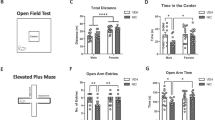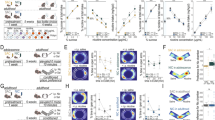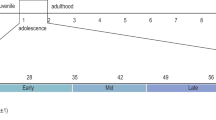Abstract
Adolescence is a developmental period, during which the brain and particularly medial prefrontal cortical (mPFC) regions thereof have not fully matured. Because epidemiological data have suggested that adolescent nicotine use may result in disturbances in cognitive function in adulthood, we investigated the long-term effects of adolescent nicotine exposure in rats. Male Wistar rats were exposed to either nicotine (three times daily, 0.4 mg/kg s.c.) or saline for 10 days during (postnatal day (PND) 34–43) or following (PND 60–69) adolescence. After 5 weeks during adulthood, separate groups of animals were tested in operant paradigms taxing attention and distinct measures of impulsivity. Visuospatial attention and impulsive action were tested in the five-choice serial reaction time task, whereas impulsive choice was assessed in the delayed reward task. Our data show that adolescent, but not postadolescent, nicotine exposure affects cognitive performance in adulthood and results in diminished attentional performance and increments in impulsive action, while leaving impulsive choice intact. This altered cognitive performance appeared to be associated with enhanced releasability of dopamine in the mPFC. Together, these data suggest that adolescence is a time window during which the brain is vulnerable to long-lasting cognitive disturbances resulting from nicotine exposure.
Similar content being viewed by others
Log in or create a free account to read this content
Gain free access to this article, as well as selected content from this journal and more on nature.com
or
References
Adriani W, Deroche-Gamonet V, Le Moal M, Laviola G, Piazza PV (2006). Preexposure during or following adolescence differently affects nicotine-rewarding properties in adult rats. Psychopharmacology (Berl) 184: 382–390.
Adriani W, Spijker S, Deroche-Gamonet V, Laviola G, Le Moal M, Smit AB et al. (2003). Evidence for enhanced neurobehavioral vulnerability to nicotine during periadolescence in rats. J Neurosci 23: 4712–4716.
Andersen SL, Thompson AT, Rutstein M, Hostetter JC, Teicher MH (2000). Dopamine receptor pruning in prefrontal cortex during the periadolescent period in rats. Synapse 37: 167–169.
Arnsten AF, Li BM (2005). Neurobiology of executive functions: catecholamine influences on prefrontal cortical functions. Biol Psychiatry 57: 1377–1384.
Bergstrom HC, McDonald CG, French HT, Smith RF (2008). Continuous nicotine administration produces selective, age-dependent structural alteration of pyramidal neurons from prelimbic cortex. Synapse 62: 31–39.
Bickel WK, Odum AL, Madden GJ (1999). Impulsivity and cigarette smoking: delay discounting in current, never, and ex-smokers. Psychopharmacology (Berl) 146: 447–454.
Brown RA, Lewinsohn PM, Seeley JR, Wagner EF (1996). Cigarette smoking, major depression, and other psychiatric disorders among adolescents. J Am Acad Child Adolesc Psychiatry 35: 1602–1610.
Casey BJ, Tottenham N, Liston C, Durston S (2005). Imaging the developing brain: what have we learned about cognitive development? Trends Cogn Sci 9: 104–110.
Chamberlain SR, Muller U, Robbins TW, Sahakian BJ (2006). Neuropharmacological modulation of cognition. Curr Opin Neurol 19: 607–612.
Chassin L, Presson CC, Rose JS, Sherman SJ (1996). The natural history of cigarette smoking from adolescence to adulthood: demographic predictors of continuity and change. Health Psychol 15: 478–484.
Cole BJ, Robbins TW (1987). Amphetamine impairs the discriminative performance of rats with dorsal noradrenergic bundle lesions on a 5-choice serial reaction time task: new evidence for central dopaminergic-noradrenergic interactions. Psychopharmacology (Berl) 91: 458–466.
Cole BJ, Robbins TW (1989). Effects of 6-hydroxydopamine lesions of the nucleus accumbens septi on performance of a 5-choice serial reaction time task in rats: implications for theories of selective attention and arousal. Behav Brain Res 33: 165–179.
Dalley JW, Mar AC, Economidou D, Robbins TW (2008). Neurobehavioral mechanisms of impulsivity: fronto-striatal systems and functional neurochemistry. Pharmacol Biochem Behav 90: 250–260.
Dappen A, Schwartz RH, O'Donnell R (1996). A survey of adolescent smoking patterns. J Am Board Fam Pract 9: 7–13.
Day M, Pan JB, Buckley MJ, Cronin E, Hollingsworth PR, Hirst WD et al. (2007). Differential effects of ciproxifan and nicotine on impulsivity and attention measures in the 5-choice serial reaction time test. Biochem Pharmacol 73: 1123–1134.
Diergaarde L, Pattij T, Poortvliet I, Hogenboom F, de Vries W, Schoffelmeer AN et al. (2008). Impulsive choice and impulsive action predict vulnerability to distinct stages of nicotine seeking in rats. Biol Psychiatry 63: 301–308.
Fried PA, Watkinson B, Gray R (2006). Neurocognitive consequences of cigarette smoking in young adults—a comparison with pre-drug performance. Neurotoxicol Teratol 28: 517–525.
Godeau E, Rahav G, Hublet A (2004). Tobacco smoking. In: Currie C, Roberts C, Morgan A, Smith R, Settertobulte W, Samdal O et al (eds). Young people's health in context. Health Behaviour in School-aged Children (HBSC) study: international report from the 2001/2002 survey. World Health Organization Europe, Copenhagen, Denmark. pp 63–72.
Granon S, Passetti F, Thomas KL, Dalley JW, Everitt BJ, Robbins TW (2000). Enhanced and impaired attentional performance after infusion of D1 dopaminergic receptor agents into rat prefrontal cortex. J Neurosci 20: 1208–1215.
Grottick AJ, Higgins GA (2000). Effect of subtype selective nicotinic compounds on attention as assessed by the five-choice serial reaction time task. Behav Brain Res 117: 197–208.
Hahn B, Shoaib M, Stolerman IP (2002). Nicotine-induced enhancement of attention in the five-choice serial reaction time task: the influence of task demands. Psychopharmacology (Berl) 162: 129–137.
Harrison AA, Everitt BJ, Robbins TW (1997). Central 5-HT depletion enhances impulsive responding without affecting the accuracy of attentional performance: interactions with dopaminergic mechanisms. Psychopharmacology (Berl) 133: 329–342.
Jacobsen LK, Krystal JH, Mencl WE, Westerveld M, Frost SJ, Pugh KR (2005). Effects of smoking and smoking abstinence on cognition in adolescent tobacco smokers. Biol Psychiatry 57: 56–66.
Jacobsen LK, Slotkin TA, Mencl WE, Frost SJ, Pugh KR (2007). Gender-specific effects of prenatal and adolescent exposure to tobacco smoke on auditory and visual attention. Neuropsychopharmacology 32: 2453–2464.
Johnson LD, O'Malley PM, Bachman JG, Schulenberg JE (2006). Monitoring the Future: National Results on Adolescent Drug Use. Overview of Key Findings 2005. NIH publication: National Institute on Drug Abuse (NIDA), Bethesda, MD. pp 278
Krishnan-Sarin S, Reynolds B, Duhig AM, Smith A, Liss T, McFetridge A et al (2007). Behavioral impulsivity predicts treatment outcome in a smoking cessation program for adolescent smokers. Drug Alcohol Depend 88: 79–82.
Markham JA, Morris JR, Juraska JM (2007). Neuron number decreases in the rat ventral, but not dorsal, medial prefrontal cortex between adolescence and adulthood. Neuroscience 144: 961–968.
Mathers M, Toumbourou JW, Catalano RF, Williams J, Patton GC (2006). Consequences of youth tobacco use: a review of prospective behavioural studies. Addiction 101: 948–958.
Miller EK, Cohen JD (2001). An integrative theory of prefrontal cortex function. Annu Rev Neurosci 24: 167–202.
Mitchell SH (1999). Measures of impulsivity in cigarette smokers and non-smokers. Psychopharmacology (Berl) 146: 455–464.
Musso F, Bettermann F, Vucurevic G, Stoeter P, Konrad A, Winterer G (2007). Smoking impacts on prefrontal attentional network function in young adult brains. Psychopharmacology (Berl) 191: 159–169.
Pattij T, Janssen MC, Vanderschuren LJ, Schoffelmeer AN, Van Gaalen MM (2007). Involvement of dopamine D1 and D2 receptors in the nucleus accumbens core and shell in inhibitory response control. Psychopharmacology (Berl) 191: 587–598.
Pattij T, Vanderschuren LJMJ (2008). The neuropharmacology of impulsive behavior. Trends Pharmacol Sci 49: 192–199.
Puumala T, Ruotsalainen S, Jakala P, Koivisto E, Riekkinen Jr P, Sirvio J (1996). Behavioral and pharmacological studies on the validation of a new animal model for attention deficit hyperactivity disorder. Neurobiol Learn Mem 66: 198–211.
Reynolds B (2004). Do high rates of cigarette consumption increase delay discounting? A cross-sectional comparison of adolescent smokers and young-adult smokers and nonsmokers. Behav Processes 67: 545–549.
Robbins TW (2005). Chemistry of the mind: neurochemical modulation of prefrontal cortical function. J Comp Neurol 493: 140–146.
Schochet TL, Kelley AE, Landry CF (2005). Differential expression of arc mRNA and other plasticity-related genes induced by nicotine in adolescent rat forebrain. Neuroscience 135: 285–297.
Schoffelmeer AN, Rice KC, Jacobson AE, Van Gelderen JG, Hogenboom F, Heijna MH et al (1988). Mu-, delta- and kappa-opioid receptor-mediated inhibition of neurotransmitter release and adenylate cyclase activity in rat brain slices: studies with fentanyl isothiocyanate. Eur J Pharmacol 154: 169–178.
Skinner MD, Aubin HJ, Berlin I (2004). Impulsivity in smoking, nonsmoking, and ex-smoking alcoholics. Addict Behav 29: 973–978.
Slawecki CJ, Thorsell AK, El Khoury A, Mathe AA, Ehlers CL (2005). Increased CRF-like and NPY-like immunoreactivity in adult rats exposed to nicotine during adolescence: relation to anxiety-like and depressive-like behavior. Neuropeptides 39: 369–377.
Slotkin TA (2004). Cholinergic systems in brain development and disruption by neurotoxicants: nicotine, environmental tobacco smoke, organophosphates. Toxicol Appl Pharmacol 198: 132–151.
Slotkin TA, MacKillop EA, Rudder CL, Ryde IT, Tate CA, Seidler FJ (2007). Permanent, sex-selective effects of prenatal or adolescent nicotine exposure, separately or sequentially, in rat brain regions: indices of cholinergic and serotonergic synaptic function, cell signaling, and neural cell number and size at 6 months of age. Neuropsychopharmacology 32: 1082–1097.
Spear LP (2000). The adolescent brain and age-related behavioral manifestations. Neurosci Biobehav Rev 24: 417–463.
Spinella M (2002). Correlations between orbitofrontal dysfunction and tobacco smoking. Addict Biol 7: 381–384.
Trauth JA, Seidler FJ, Slotkin TA (2000). Persistent and delayed behavioral changes after nicotine treatment in adolescent rats. Brain Res 880: 167–172.
Van Andel I, Rambali B, Van Amsterdam J, Wolterink G, Van Aerts LA, Vleeming W (2003). Nicotine Addiction. RIVM: Bilthoven.
Van Gaalen MM, Brueggeman RJ, Bronius PF, Schoffelmeer AN, Vanderschuren LJ (2006a). Behavioral disinhibition requires dopamine receptor activation. Psychopharmacology (Berl) 187: 73–85.
Van Gaalen MM, Van Koten R, Schoffelmeer AN, Vanderschuren LJ (2006b). Critical involvement of dopaminergic neurotransmission in impulsive decision making. Biol Psychiatry 60: 66–73.
Wade TR, de Wit H, Richards JB (2000). Effects of dopaminergic drugs on delayed reward as a measure of impulsive behavior in rats. Psychopharmacology (Berl) 150: 90–101.
Winstanley CA, Dalley JW, Theobald DE, Robbins TW (2003). Global 5-HT depletion attenuates the ability of amphetamine to decrease impulsive choice on a delay-discounting task in rats. Psychopharmacology (Berl) 170: 320–331.
Winstanley CA, Eagle DM, Robbins TW (2006a). Behavioral models of impulsivity in relation to ADHD: translation between clinical and preclinical studies. Clin Psychol Rev 26: 379–395.
Winstanley CA, Theobald DE, Dalley JW, Cardinal RN, Robbins TW (2006b). Double dissociation between serotonergic and dopaminergic modulation of medial prefrontal and orbitofrontal cortex during a test of impulsive choice. Cereb Cortex 16: 106–114.
Acknowledgements
We thank R Binnekade and H Raasø for excellent technical support.
Author information
Authors and Affiliations
Corresponding author
Additional information
DISCLOSURES/CONFLICTS OF INTERESTS
The authors do not have any conflicts of interest to disclose.
Rights and permissions
About this article
Cite this article
Counotte, D., Spijker, S., Van de Burgwal, L. et al. Long-Lasting Cognitive Deficits Resulting from Adolescent Nicotine Exposure in Rats. Neuropsychopharmacol 34, 299–306 (2009). https://doi.org/10.1038/npp.2008.96
Received:
Revised:
Accepted:
Published:
Issue date:
DOI: https://doi.org/10.1038/npp.2008.96
Keywords
This article is cited by
-
Adolescent nicotine exposure induces long-term, sex-specific disturbances in mood and anxiety-related behavioral, neuronal and molecular phenotypes in the mesocorticolimbic system
Neuropsychopharmacology (2024)
-
Preconception paternal morphine exposure leads to an impulsive phenotype in male rat progeny
Psychopharmacology (2021)
-
A Retrospective Cross-Sectional Study on the Prevalence of E-cigarette Use Among College Students
Journal of Community Health (2021)
-
Nicotine exposure and transgenerational impact: a prospective study on small regulatory microRNAs
Scientific Reports (2014)
-
Effects of chronic nicotine, nicotine withdrawal and subsequent nicotine challenges on behavioural inhibition in rats
Psychopharmacology (2012)



